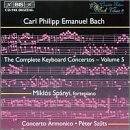| All Artists: Carl Philipp Emanuel Bach, Concerto Armonico (Budapest), Miklós Spányi Title: Bach: Keyboard Concertos, Vol. 5 Members Wishing: 0 Total Copies: 0 Label: Bis Release Date: 3/18/1997 Album Type: Import Genre: Classical Styles: Chamber Music, Forms & Genres, Concertos, Historical Periods, Classical (c.1770-1830), Instruments, Keyboard Number of Discs: 1 SwapaCD Credits: 1 UPC: 789368610921 |
Search - Carl Philipp Emanuel Bach, Concerto Armonico (Budapest), Miklós Spányi :: Bach: Keyboard Concertos, Vol. 5
 | Carl Philipp Emanuel Bach, Concerto Armonico (Budapest), Miklós Spányi Bach: Keyboard Concertos, Vol. 5 Genre: Classical
|
Larger Image |
CD Details |
CD ReviewsMature Music, Grand Performance, Superb Engineering Leslie Richford | Selsingen, Lower Saxony | 05/29/2007 (5 out of 5 stars) "Carl Philipp Emanuel Bach (1714 - 1788): The Complete Keyboard Concertos Volume 5, containing: 1. Concerto in D major, H. 414 (Wq. 11) - World Première Recording; 2. Concerto in A major, H. 422 (Wq. 19) - World Première Recording; 3. Concerto in E major, H. 417 (Wq. 14). Performed by Miklós Spányi, fortepiano; Concerto Armonico (strings: 6-2-1-1; transverse flute; two natural trumpets; two natural horns; timpani); directed jointly by Miklós Spányi and Péter Szüts. Recorded in March 1996 at the Angyalföld Reformed Church in Budapest, Hungary, and released in 1997 as BIS CD-785. Total playing time: approx. 73 minutes.
This is the fifth volume of a long series of BIS recordings documenting the complete works for harpsichord and strings by the second son of Johann Sebastian Bach, Carl Philipp Emanuel. The notes in the CD booklets are provided by members of the team at the University of Maryland who are working on a complete edition of Emanuel Bach's works. Miklós Spányi has decided on the basis of his musical intuition which keyboard instrument to use in each instance - on this fifth volume we hear a copy of a 1749 Silbermann fortepiano, a very rare instrument (pictured in color on the back cover of the booklet). Spànyi has carefully compared the autograph manuscripts with later revisions by the composer himself, and here opts for the later versions with parts for winds (H. 414 has trumpets and timpani in the outer movements; H. 422 has a single flute accompanying the strings in the slow movement; and H. 417 has two horns in the faster outer movements). In his highly interesting notes, Spányi gives his justification for every decision; his decision to use the later wind parts appears to have been made after his colleagues from the Concerto Armonico implored him to try them out and when they did so, it all sounded so superb that there was no question of not recording them! Carl Philipp Emanuel Bach was, in the eighteenth century, the one people meant when they spoke of "Bach". He was born when his father was 29 years old, spent his youth learning the musician's trade with his father in Leipzig and, at the age of 20, moved to Frankfurt an der Oder in order to study law (but where he also took charge of musical activities). In 1738 he moved again, this time to Berlin where he became harpsichordist at the Court of the future King of Prussia, Frederick (the Great) and where he published his famous theoretical treatise "Essay on the True Way of Playing the Keyboard". In 1768 he was called to be director of church music in the city of Hamburg, where he remained until his death. Altogether he wrote 64 works for keyboard and strings, but also many works for clavichord or harpsichord solo, for pianoforte, a good deal of chamber music, songs and sacred vocal works. His life spanned most of the 18th century, and his name is usually associated with the musical version of "Sturm und Drang" (infelicitously translated as "storm and stress") or "Empfindsamkeit" (sensibility). His works for keyboard and string ensemble are as important for the development of the piano concerto as are Haydn's symphonies for the classical symphony. The three concertos on this CD were written between 1743 and 1746 and show us something of the early mastery of C. Ph. E. Bach. Having found his own style, he now began to experiment with new effects - which, some 10 years later, he increased with the addition of wind parts. The outer movements of H. 414 are, of course, stirring and martial, but I found the slow movement (Adagio non molto) to be even more interesting with some unusual string playing. H. 422 is the most mature piece on this recording and includes a demonstration of the "pedal effect" which could be so sensationally achieved with the mechanics of Silbermann's fortepianos. H. 417, which closes the recording, has some equally wonderful moments, and the natural horns in the outer movements lend the whole great nobility, despite what Jane R. Stevens describes as a "rollicking" last movement. The team which was producing this series had obviously grown together by this time, so that I felt that this was definitely the best volume so far - the mature music being the main reason for this, but also the grand performance and the superb BIS engineering. Anyone wanting to bridge the musical gap between Johann Sebastian Bach and Mozart should listen in to this series!" |

 Track Listings (9) - Disc #1
Track Listings (9) - Disc #1